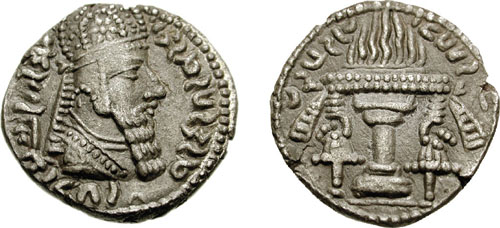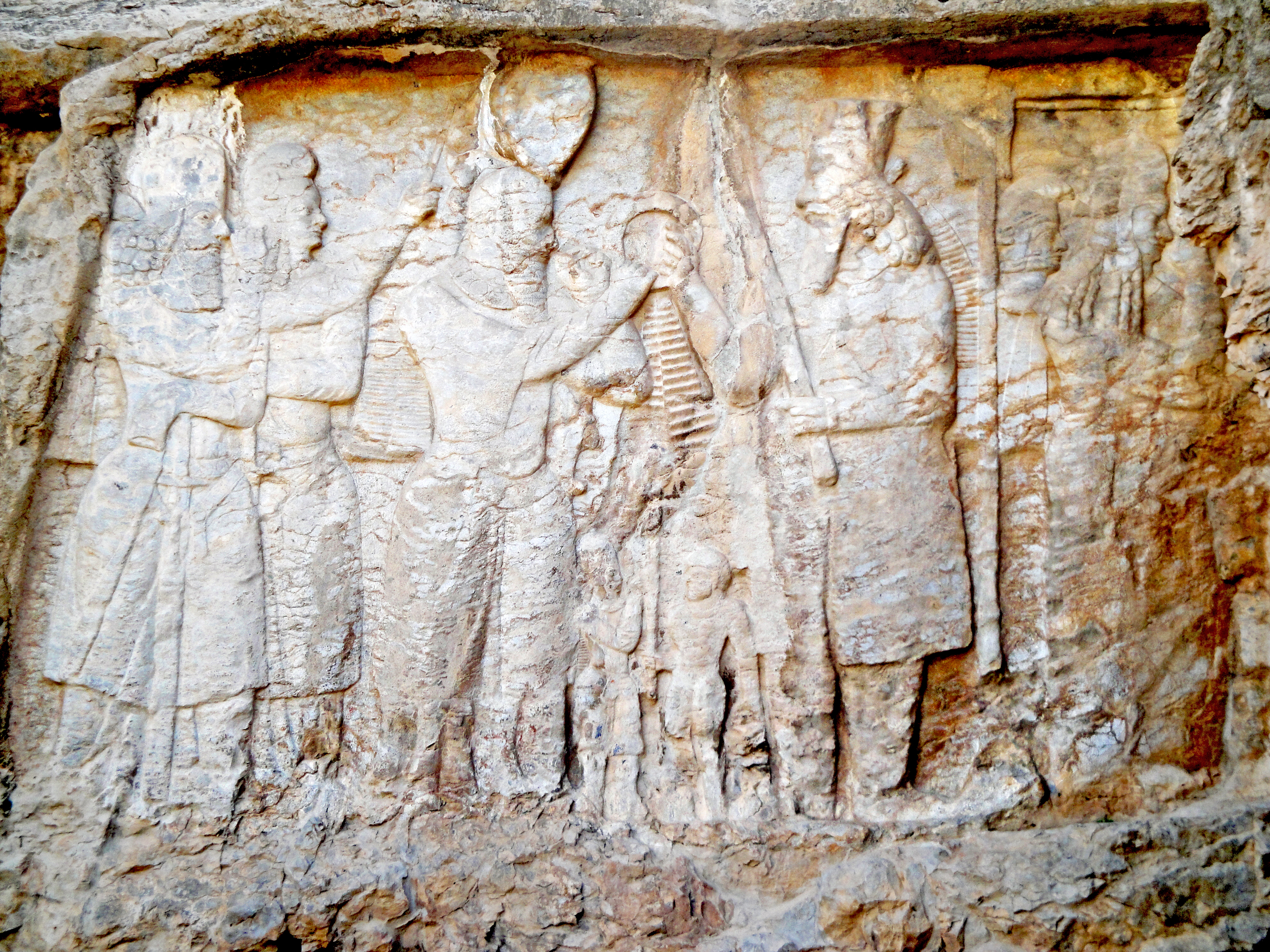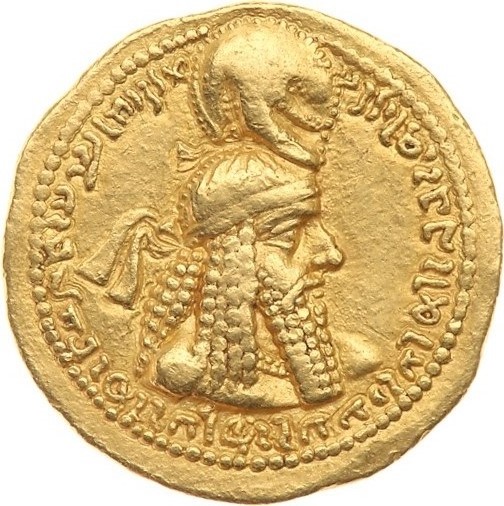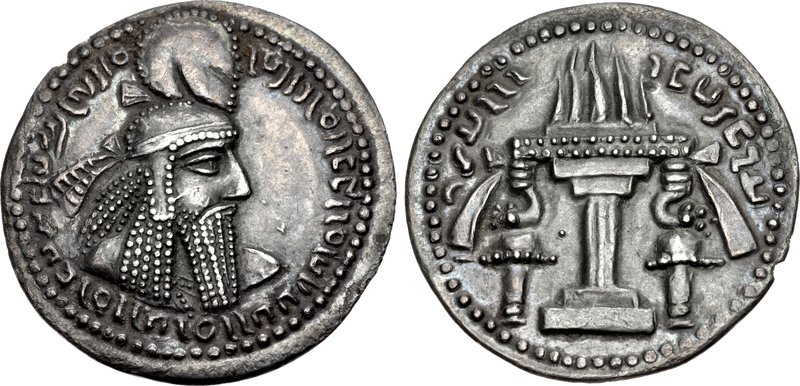Ardashir I, King of Iran, -241
Enlarge text Shrink text- Kārnāmah-i Ardashīr Pāpakān. Russian & Pahlavi. Kniga dei︠a︡ni Ardashira syna Papaka, 1987:p. 161 (Ardašir, son of Papak)
- LC manual cat.(hdg.: Ardashir I, King of Iran, d. 241; variants: Artaxerxes I, Ardashīr Pāpakān; Ardashir i Papakan; Artashatr I; Ardashír Bábakán; founder of the Sassanid Empire, ca. 227 A.D.)
- Enc. Iranica, v. 2(Ardas̆īr I (?-242 A.D.), founder of the Sassanian empire; Middle Persian spelling, ʾrths̆tr, pronounced Artas̆īr; death date is a source of scholarly controversy; it is now accepted that he lived until the early part of242 A.D.)
Ardashir I (Middle Persian: 𐭠𐭥𐭲𐭧𐭱𐭲𐭥, romanized: Ardašīr), also known as Ardashir the Unifier (180–242 AD), was the founder of the Sasanian Empire, the last empire of ancient Iran. He was also Ardashir V of the Kings of Persis, until he founded the new empire. After defeating the last Parthian shahanshah Artabanus IV on the Hormozdgan plain in 224, he overthrew the Arsacid dynasty and established the Sasanian dynasty. Afterwards, Ardashir called himself shahanshah and began conquering the land that he called Eranshahr, the realm of the Iranians. There are various historical reports about Ardashir's lineage and ancestry. According to al-Tabari's History of the Prophets and Kings, Ardashir was son of Papak, son of Sasan. Another narrative recorded in Kar-Namag i Ardashir i Pabagan and Ferdowsi's Shahnameh states that Ardashir was born from the marriage of Sasan, a descendant of Darius III, with the daughter of Papak, a local governor in Pars. According to al-Tabari's report, Ardashir was born in the outskirts of Istakhr, Pars. Al-Tabari adds that Ardashir was sent to the lord of Fort Darabgard when he was seven years old. After the lord's death, Ardashir succeeded him and became the commander of Fort Darabgard. Afterwards, Papak overthrew the local Persian shah named Gochihr and appointed his son, Shapur, instead of him. Shapur and his father, Papak, suddenly died and Ardashir became the ruler of Pars. Tension rose between Ardashir and the Parthian empire, and eventually on April 28, 224, Ardashir faced the army of Artabanus IV in the Hormozdgan plain, where the Parthian shahanshah was defeated and killed in battle. According to the royal reports, it was Papak who overthrew Gochihr, the local Persian shah, and appointed his son, Shapur, instead of him; Ardashir refused to accept Shapur's appointment and removed his brother and whosoever stood against him and then minted coins with his face drawn on and his father, Papak's behind. It is probable that the determining role that is stated about Ardashir in leading the rebellion against the central government is the product of the later historical studies. Papak had probably united most of Pars under his rule by then. Ardashir had an outstanding role in developing the royal ideology. He tried to show himself as a worshiper of Mazda and a descendant of the gods who possesses khvarenah, the divine royal glory attributed to kings in Zoroastrianism. In order to legitimize his rule and delegitimize that of the Parthians, he claimed descent from mythical Iranian shahs and presented himself as a continuator of the Achaemenids, the creators of the first Persian empire, although the current belief is that the early Sasanians did not know much about the history of the Achaemenids. On the other hand, some historians believe that the first Sasanian shahanshahs were familiar with the Achaemenids and their successors deliberately turned to the legendary Kayanians. They knowingly ignored the Achaemenids in order to attribute their past to the Kayanians; and that was where they applied holy historiography. In order to remark his victories, Ardashir carved petroglyphs in Firuzabad (the city of Gor or Ardashir-Khwarrah), Naqsh-e Rajab and Naqsh-e Rustam. In his petroglyph in Naqsh-e Rustam, Ardashir and Ahura Mazda are opposite to each other on horsebacks and the corpses of Artabanus and Ahriman are visualized under the hooves of the horses of Ardashir and Ahura Mazda. It can be deduced from the picture that Ardashir assumed or wished for others to assume that his rule over the land that was called "Iran" in the inscriptions was designated by the lord. The word "Iran" was previously used in Avesta and as "the name of the mythical land of the Aryans". In Ardashir's period, the title "Iran" was chosen for the region under the Sasanian rule. The idea of "Iran" was accepted for both the Zoroastrian and non-Zoroastrian societies in the whole kingdom and the Iranians' collective memory continued and lived on in the various stages and different layers of the Iranian society until the modern period today. What is clear is that the concept of "Iran" previously had a religious and ethnic application and then ended up creating its political face and the concept of a geographical collection of lands.
Read more on Wikipedia >
 Personality
Personality


.jpg)









